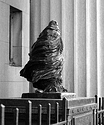In New York, where there's a critical mass of media industry, and photography to support the media industry, there are labs to support film and digital--fewer than there used to be, but enough to meet demand certainly. Of course we all know that print and internet need digital files these days, so more and more is digital, but at the high end, if a photographer's vision is best achieved with film, the dip-and-dunk lines are still running, and we've still got 4-hour turnaround on E-6 without a rush order, and if it's the kind of job where it is more expensive to pay the models and assistants to wait on set than to rush the film, rush and double rush are still available, and labs will work with major clients who shoot film to make things work for them.
I don't know how this plays out in other cities, but I suspect we're just seeing concentration of media photography anyway in major cities like New York, Los Angeles, and Chicago, because that's where the rest of the industry is, and film is a viable commercial medium in those places where there are businesses that can afford the luxury of film. In a high-circulation slick fashion magazine where a full page can cost more than $100,000 just for the ad space, the cost of film and processing and whatever one needs to do to achieve the desired level of "convenience" is insignificant.
I don't know how this plays out in other cities, but I suspect we're just seeing concentration of media photography anyway in major cities like New York, Los Angeles, and Chicago, because that's where the rest of the industry is, and film is a viable commercial medium in those places where there are businesses that can afford the luxury of film. In a high-circulation slick fashion magazine where a full page can cost more than $100,000 just for the ad space, the cost of film and processing and whatever one needs to do to achieve the desired level of "convenience" is insignificant.







